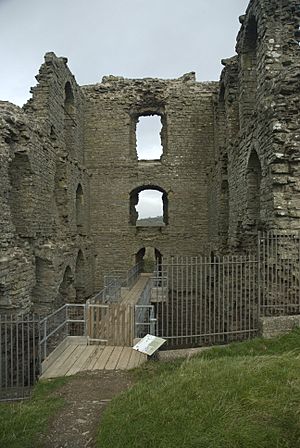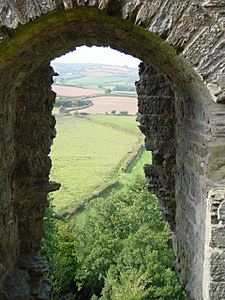Clun Castle facts for kids
Quick facts for kids Clun Castle |
|
|---|---|
| Shropshire, England | |
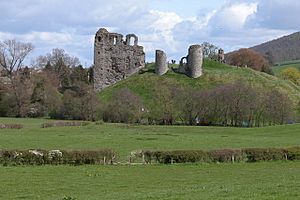
Clun Castle
|
|
| Coordinates | 52°25′18″N 3°02′01″W / 52.4216°N 3.0337°W |
| Type | Bailey |
| Site information | |
| Owner | Duke of Norfolk |
| Controlled by | English Heritage |
| Condition | Ruined |
Clun Castle is a ruined castle located in the small town of Clun, Shropshire, England. It was built by a Norman lord named Robert de Say after the Normans took over England. Clun Castle became a very important castle for the Marcher lords in the 12th century. These lords were powerful rulers who controlled the lands along the border between England and Wales.
For many years, the castle belonged to the Fitzalan family. It played a key role in protecting the area from attacks by the Welsh. Over time, the family started to prefer their more luxurious Arundel Castle and slowly stopped using Clun Castle as their main home. In the 14th century, the Fitzalans turned Clun Castle into a hunting lodge with beautiful pleasure gardens. However, by the 16th century, much of the castle was in ruins. After the English Civil War, parts of the castle were deliberately damaged in 1646 to prevent it from being used as a fortress. Clun Castle stayed in poor condition until it was repaired in the 1890s.
Today, Clun Castle is a Grade I listed building, which means it's a very important historic site. It is also a Scheduled Monument, giving it special protection. The castle is owned by the Duke of Norfolk, who also holds the title of Baron Clun. English Heritage helps manage and preserve the site for everyone to visit.
Contents
Exploring Clun Castle's Design
Clun Castle sits on a bend in the River Clun. It looks out over the small town of Clun and its church. The river naturally protects the castle from the north and west. The main part of the castle, called the keep, stands on a large mound. Historians believe this mound is mostly a natural rock formation that was shaped by people. Other smaller mounds around the main one also helped form the castle's defenses.
The remains of the 80 ft (24 m) tall, four-story great keep are still visible on the north side of the mound. This rectangular keep is typical of late Norman castles. It measures 68 by 42 ft (21 by 13 m) and has strong pilaster buttresses and round-headed Norman windows. What's unusual is that the keep is not in the very center of the mound. This design likely helped to spread its weight and prevent too much pressure on the mound. You can see a similar design at Guildford Castle.
The ground floor of the keep was used for storage. The three floors above were where the family lived. Each floor had its own large fireplace and five windows. While the great keep looks very strong, it was built to be both secure and comfortable. It has relatively few arrowslits (narrow openings for archers). Many of the arrowslits you see from the outside are actually fake.
On the highest point of the main mound, you can still see parts of an older, smaller square keep. This older part probably dates back to the 11th or 12th centuries. South of this, you can just make out the remains of a bridge. This bridge connected the main mound to a mound to the south-west and was likely the main way into the town. South of the bridge was the gatehouse, and the foundations of a large round tower are visible to the south-west. Along the west side, there are remains of two solid turrets. These might have been built to look like parts of Château Gaillard in France.
Inside the main bailey (the castle courtyard), there were once many buildings. These included a grange (a farm building), a stable, and a bakehouse. You can also see the earthworks (old mounds and ditches) of two more bailey walls on the east side of the castle.
The land around Clun Castle was also developed. You can still see the outline of a pleasure garden in the field across the River Clun to the west. To the north-east, there are remains of a fish pond with a sluice (a water control gate) connecting it to the river.
Clun Castle Through Time
Early Years: 11th–12th Centuries
Before the Normans arrived, the area of Clun was owned by a person named Eadric the Wild. This region was rugged, had few people, and was covered in thick forests. Robert de Say, a Norman lord, took control of the land from Edric. Robert built the first Clun Castle, which was a motte castle with two courtyards. Robert held the castle from the Earl of Shrewsbury until 1102. After a rebellion that year, Robert and his family held the castle directly from the King.
Robert's daughter married a local Welsh lord, Cadwgan ap Bleddyn. In 1109, Cadwgan had to leave his home in Powys and might have lived at Clun Castle for a while. Their son, Henry de Say, inherited the castle in 1098. His son, Helias de Say, controlled the castle until he died in 1165. Under Helias, the Say family's lands were split. Helias's daughter, Isabella de Say, received an expanded estate centered on Clun.
Around the same time, King Henry I set up a new system to guard Clun Castle. This was probably because of many Welsh attacks after a rebellion in 1094. Under this system, knights from lands to the east of Clun had to help protect the castle. Each knight had to serve for forty days a year, likely during times of crisis. King Henry II continued to focus on Clun as a key border defense. He spent a lot of money on the castle between 1160 and 1164. The castle also received military help from twenty-five local Welsh settlements.
The area around the castle became a Marcher Barony, known as the Honour of Clun. This meant it was governed by its own laws, not English law. The Marcher Lord of Clun Castle was known for having the right to carry out punishments for crimes himself, rather than as the king's representative.
Isabella de Say married William Fitz Alan, another powerful local lord. William was appointed the High Sheriff of Shropshire by Adeliza of Louvain, King Henry I's second wife. After Henry I died, during a period called the Anarchy, William supported the Empress Matilda. In 1138, he held Shrewsbury Castle against King Stephen for four weeks. William escaped before the castle fell and lived in exile for fifteen years until Henry II returned in 1153.
Isabella married two more times after William's death. Her later husbands controlled Clun Castle through marriage. When she died in 1199, the castle went to her son from her first marriage, the second William Fitz Alan. This created a combined lordship of Oswestry and Clun, which became a very powerful noble family. William built the tall, off-center Norman keep that you see today. He combined strong defenses with a more comfortable living style. William had been with King Richard I when Château Gaillard was built in Normandy. It seems that the unique round towers William built at Clun were inspired by those at Gaillard.
Challenges in the 13th Century
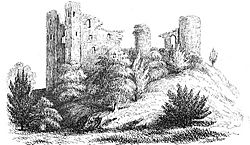
In the 13th century, Shropshire was on the front line of efforts by Prince Llywelyn the Great to strengthen Welsh power. This was made more difficult by the poor relationship King John had with his local lords. For many years, people mistakenly believed that Clun Castle was attacked by the Welsh under Prince Rhys ap Gruffydd in 1196. This story was a mix-up with Colwyn Castle, which was attacked that year.
William Fitz Alan died in 1210, leaving the castle to his oldest son, also named William Fitz Alan. However, King John demanded a huge payment of 10,000 marks for William to inherit his lands. Since William couldn't pay, Clun Castle was given to Thomas de Eardington instead. William died soon after, in 1215. His brother, John Fitz Alan, who was a close friend of Llywelyn the Great, immediately fought against the king. He quickly took Clun and Oswestry back from royal control. In 1216, King John's forces attacked and burned Oswestry town. They then surprised and captured Clun Castle. John Fitz Alan later reached an agreement with King John's successor, King Henry III, in 1217 after finally paying the 10,000 marks.
In 1233–34, during a conflict between King Henry III and Llywelyn the Great, there were doubts about the loyalty of John Fitzalan. To ensure its reliability as a key fortress, Clun Castle was guarded by royal troops in 1233. The castle successfully defended against an attack by Llywelyn that year, although the town of Clun itself was destroyed.
In 1244, John FitzAlan inherited the castle from his father. He also became the Earl of Arundel. The Welsh border was still unstable, and security worsened as the Welsh prince Llywelyn up Gruffudd led many raids into English lands. John's son, another John Fitzalan, inherited the castle. He married Isabella, from the powerful neighboring Mortimer family. In 1272, John died, leaving a young son, Richard. While Richard was a child, Roger Mortimer of Wigmore controlled the castle. A group of experts who examined the castle noted that it was "small but strongly built," but needed some repairs, especially the bridge and the roof of one of the towers.
Later Years: 14th–17th Centuries
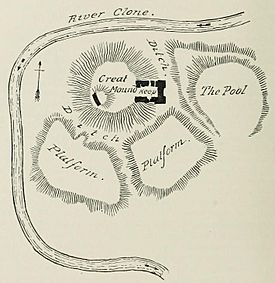
The invasion of North Wales by King Edward I in the 1280s greatly reduced the threat of Welsh attacks. This meant that strong military castles like Clun Castle were no longer as necessary. Meanwhile, the FitzAlan family had gained Arundel Castle through marriage in 1243. This new castle was a much more comfortable place for the Earls of Arundel, and it became their main home. By the 14th century, the FitzAlan family had turned Clun Castle into a hunting lodge with pleasure gardens. They also kept a large horse stud (a place for breeding horses) at the castle, similar to their collections at Chirk and Holt castles.
King Richard II tried to weaken the power of the Arundel family. He took Clun Castle from the Fitz Alan family in 1397 after executing Richard FitzAlan. Richard II gave it to the Duke of York. However, when Richard II lost power, and Thomas FitzAlan regained favor, the castle was returned to the family. There was renewed interest in Clun Castle during the Glyndŵr Rising (a Welsh rebellion) from 1400–15. Thomas FitzAlan played a key role in stopping the revolt. The castle was strengthened again and saw some action against the Welsh rebels led by Owain Glyndŵr.
By the 16th century, the historian John Leland noted that Clun Castle was becoming more and more ruined. Philip Howard, the 20th Earl of Arundel, died in 1595 while under legal punishment. King James I then gave Clun Castle to Henry Howard, 1st Earl of Northampton. By the time of the English Civil War (1642–46), the castle was abandoned and saw no fighting. However, it was deliberately damaged by Parliamentary forces in 1646 to prevent it from ever being used as a fortress again. The castle changed hands several times in the following years, including a period when it was owned by Clive of India. In 1825, the 19th-century author Sir Walter Scott used Clun Castle as the inspiration for the castle "Guarde Doleureuse" in his novel The Betrothed.
Clun Castle Today
In 1894, the Duke of Norfolk bought the site. He was a descendant of the original FitzAlan family. The Duke started a project to preserve the castle and make sure it was stable. Today, Clun Castle is a Grade I listed building and a Scheduled Monument. The site is open to the public and is managed by English Heritage, allowing visitors to explore its history.
Images for kids



